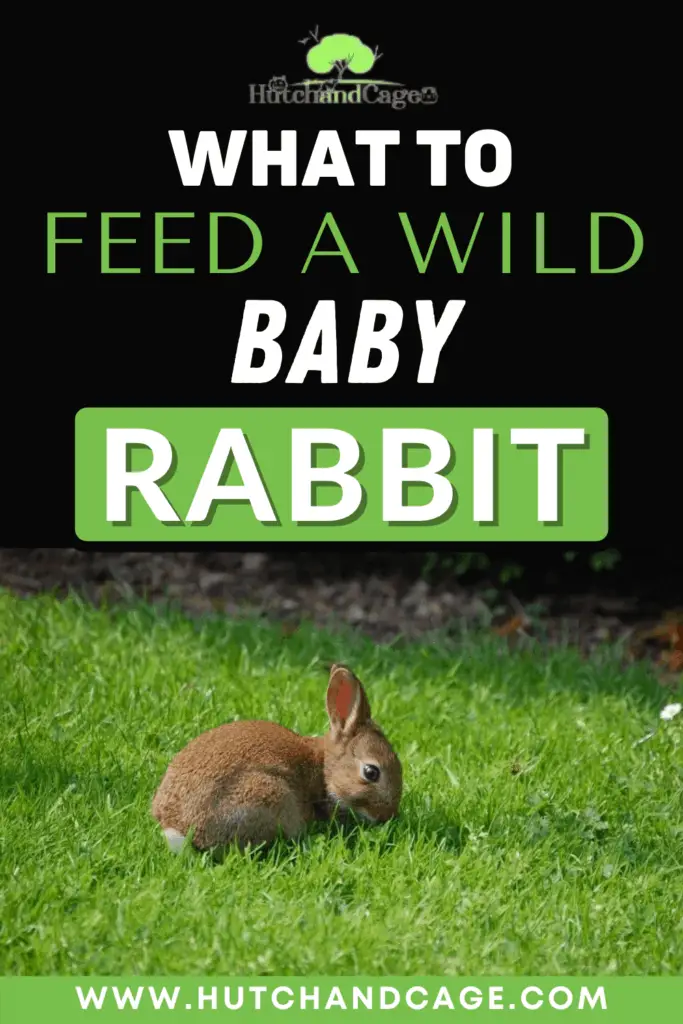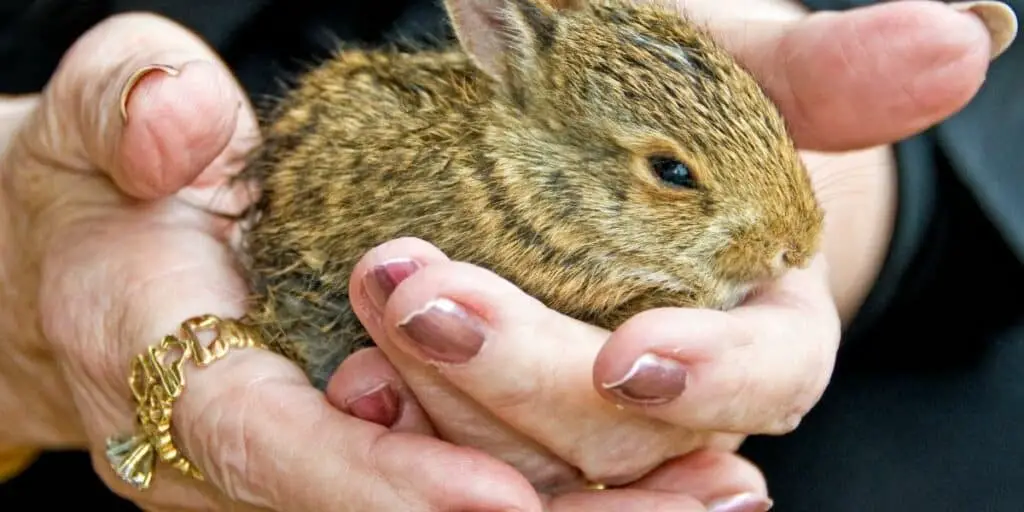Table of Contents
Have you found a wild rabbit that needs to be fed?
It is not uncommon to encounter a lone litter or single baby rabbit when walking the dog out in the country or hiking your favorite nature trail.
If you do find a wild baby rabbit, your first thoughts are likely to be how you can best meet its needs and help it survive.
What to feed a wild baby rabbit is certainly important but before we run through the best feeding options for wild rabbit kittens, we will help you think carefully about how you approach animals within their natural habitat.
You must establish that that baby wild rabbit is truly abandoned
Though wild rabbit kittens may be found alone, they are often not abandoned but simply left in an open nest while the mother rabbit leaves in search of food.

The mother may not return to the nest before nightfall. If you turn up in the intervening hours and disturb the nest, the mother may abandon her young or be distressed and exhausted by frantically searching for kittens that you have removed unnecessarily.
Watching and waiting is always best
If you give the situation time, you are likely to find that mom returns to the nest at nightfall and all is well. The cautious approach is recommended because the survival outcomes for orphaned rabbits are poor even when rescued.

No more than 10% make it due to their very specific care needs. For this reason, wildlife organizations actively discourage the removal of kittens from their natural environment unless the conditions are very poor.
Are you sure the young rabbit is orphaned/abandoned?
When dealing with wild animals it is difficult to make a call. Many animal rescuers would encourage you to err on the side of caution and leave a nest with baby rabbits undisturbed. Signs that the mother is unlikely to return include:
- A dead mother rabbit
- Signs of predation (blood, fur, etc) at the nest site
- Fresh roadkill
- A nest that has already been disturbed, flooded, or infested.
In these situations, it may be appropriate to remove surviving baby rabbits or seek advice from your local vet or animal welfare group. And of course, in the short term, you have earned yourself some baby wild rabbits to feed and care for.
How wild baby rabbits feed
Baby rabbits spend most of their early life in the simple grass and fur-lined nest prepared by their mother just before birth. A litter of up to 8 newborns will require feeding with mothers milk once in the morning and once in the evening.
They are born without teeth, or fur and their eyes are closed, so they are dependent on mom. The mother’s milk is incredibly rich and so the young do not require frequent feeding.
At around the 2 to 3 week stage, the baby rabbits get their first teeth and begin to nibble on tender grasses and shoots, after a month they can venture outside of the nest.
What are the signs that a baby rabbit needs feeding?
If the conditions suggest to you that the kittens are orphaned and you cannot get them to a wildlife rehabber quickly, you will need to assess the rabbits for dehydration and hunger. Though this is best done by the experts you can look for the following signs:
- The rabbit babies feel cold.
- The rabbit babies look thin.
- The skin at the back of the kitten’s neck does not spring back when pinched
- Rub the genital area to stimulate urine elimination, gritty brown urine indicates that they are dehydrated and have not been helped to urinate in a while.
- Flies, larvae bleeding, and convulsing are very bad signs and mean that the rabbit should be taken to a vet urgently.
What to feed a wild baby rabbit
Feeding a litter of orphaned wild rabbits is a massive undertaking as you need to assess them continuously and respond to their needs. Place the kittens in a fleece-lined box with high sides (baby rabbits can jump).
Keeping the little ones warm will improve their acceptance of the foods you offer.
If you are nursing very young kittens the demands on your time are higher, as they get older solid foods can be left in the bottom of the box. Here is a sample stage by stage feeding guide.
- Formula feeding nursing baby rabbits
Rabbit mother’s milk is very calorific and the substitute milk feeding regimen aims to recreate this by mixing powdered cat milk and heavy cream, diluting with water.
The mixture should be warmed as it helps the young rabbits feed better. The milk substitute is delivered via a syringe or dropper with a cat replacement nipple on the end.
Feeds should be 6-hourly, though some animal rescuers will feed the young, smaller quantities more frequently. Baby rabbits will take between 1 and 2 cubic centimeters each feeding, increasing with their size. A full rabbit will have a rounded stomach.
- When teeth emerge introduce greens to their box
Soft gentle greens like clover can be placed by the young rabbits for them to nibble on once teeth emerge, these should be increased to form the main part of the rabbit’s diet. Vegetation should be introduced to the rabbits with the roots and soil attached as much as possible. Solid foods for wild baby rabbits include:
- wild carrot greens
- dandelion greens
- Apple
- Queen Anne’s Lace
- wheat germ
- grass
Tips for successfully feeding baby wild rabbits
Proper handling is vital. These young rabbits can startle easily and leap straight out of your hand when being handled. This helpful video demonstrates the proper position and feeding technique for a wild baby rabbit.
You will need to help wild baby rabbits eliminate waste. You can do this by rubbing the baby rabbit’s tummy and genital area with a warm damp washcloth. If they are bloated you can immerse them up to the waist in warm water which can also help them void urine and waste.
Persevere with hand feeding. Don’t rush and don’t force-feed. It can take the kit’s time to adjust to feeding from a syringe. They will reject the feed when they are full.
Offer water with solids. Once your wild rabbits are eating their natural foods, a little water can be offered though they receive hydration from their greens.
Once a natural diet is established think about releasing the young rabbits. Remember that these cuties are wild and will fare best returning to their habitat.
Rounding up
Hopefully, you won’t need to feed newborn wild rabbits, but knowing the correct feeding regimens is worthwhile especially if you live or spend time in the great outdoors amongst rabbits and hares.
Always seek expert advice for caring for orphaned wild rabbits and where available the assistance of an animal rehabilitation organization to support them in becoming established in the wild.





